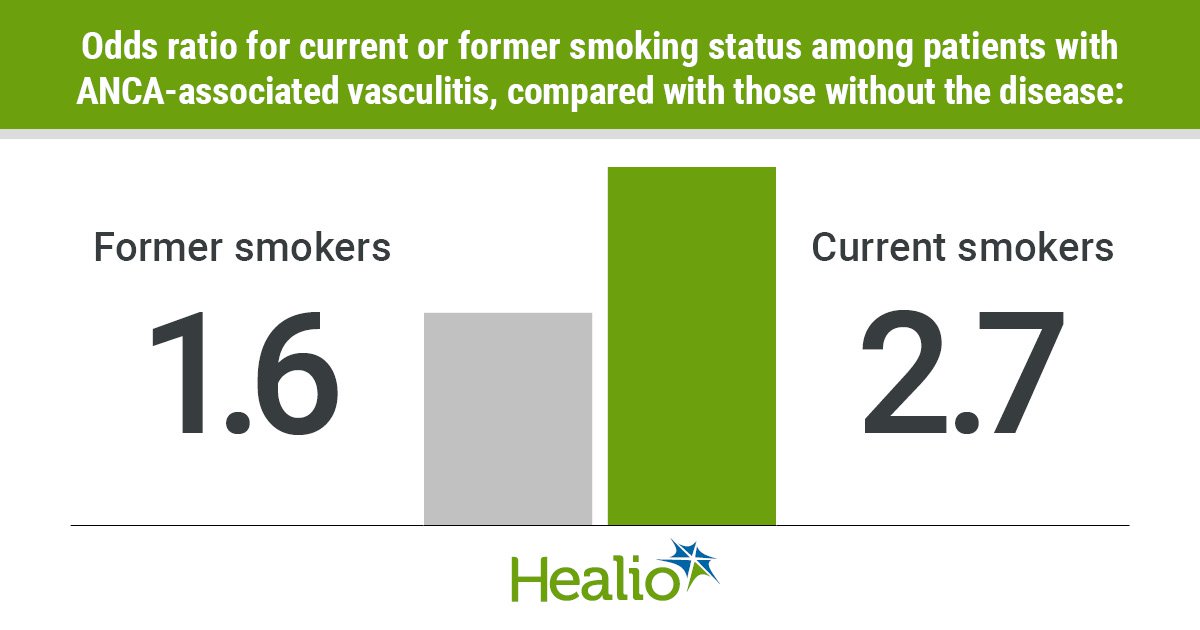Cigarette smoking increases risk for ANCA-associated vasculitis

Cigarette smoking was associated with ANCA-associated vasculitis, particularly myeloperoxidase ANCA-positive vasculitis, according to data published in JAMA Internal Medicine.
“We have an incomplete understanding of risk factors for ANCA-associated vasculitis,” Zachary S. Wallace, MD, MSc, of Massachusetts General Hospital, told Healio Rheumatology. “In other autoimmune conditions, like rheumatoid arthritis, we know that smoking is a risk factor, but this has not been previously studied in AAV in a robust way.”
“A poor understanding of risk factors limits our ability to provide recommendations on how to reduce one’s risk of AAV and the general counseling we provide patients with AAV,” he added. “For instance, it may be wise for AAV patients who currently smoke to quit smoking for many reasons, one of which might be that smoking could contribute to the pathogenesis of AAV.”
To analyze the association between cigarette smoking and ANCA-associated vasculitis, Wallace and colleagues conducted a case-control study of patients who were assessed and treated at Partners HealthCare, in the Boston area. The cohort comprised 848 consecutive cases of ANCA-associated vasculitis diagnosed between Jan. 1, 2002, and Dec. 31, 2017. Researchers included 473 participants in the final analysis after 11 were excluded due to incomplete smoking data. They also randomly selected 1,419 control participants without ANCA-associated vasculitis from the Partners HealthCare Biobank.

Those with ANACA-associated vasculitis were matched with the control population based on sex, race and age. Investigators assessed data on smoking status and pack-years through electronic medical records and questionnaires. They compared the two groups using conditional logistic regression to assess the link between cigarette smoking and ANCA-associated vasculitis.
According to the researchers, patients with ANCA-associated vasculitis were more likely to be former (OR = 1.6; 95% CI, 1.3-2) or current (OR = 2.7; 95% CI, 1.8-4.1) smokers. Further, there was a dose-response relationship related to pack-years of exposure (P<.001).
These links were particularly strong among those with MPO-ANCA–positive vasculitis, with an OR of 1.7 (95% CI, 1.3-2.3) for former smokers and 3.5 (95% CI, 2.1-6.1) for current smokers. However, these associations were not especially strong among patients with PR3-ANCA–positive disease, with ORs of 1.3 (95% CI, 0.9-2) and 1.7 (95% CI, 0.8-3.5), respectively. These links remained strong after stratifying by selected demographics and disease manifestations, the researchers wrote.
“This study is the first large study to evaluate this question and provide strong evidence that smoking is a risk factor for AAV,” Wallace said. “It also adds a novel observation to the growing list of differences reported between PR3- and MPO-ANCA+ patients since we observed the association between smoking and risk of AAV was particularly strong among MPO-ANCA+ patients. Our findings therefore add further evidence to differences in pathogenesis between MPO- and PR3-ANCA+ patients which highlight the need to consider these as key, distinct subgroups in future studies, especially those studying risk factors.”
He added: “Identifying smoking as a risk factor also raises further questions about whether the formation of ANCA autoantibodies is influenced by respiratory exposures, therefore improving our understanding of the disease’s pathogenesis and avenues for future investigation.” – by Jason Laday
Disclosures: The researchers report no relevant financial disclosures.
